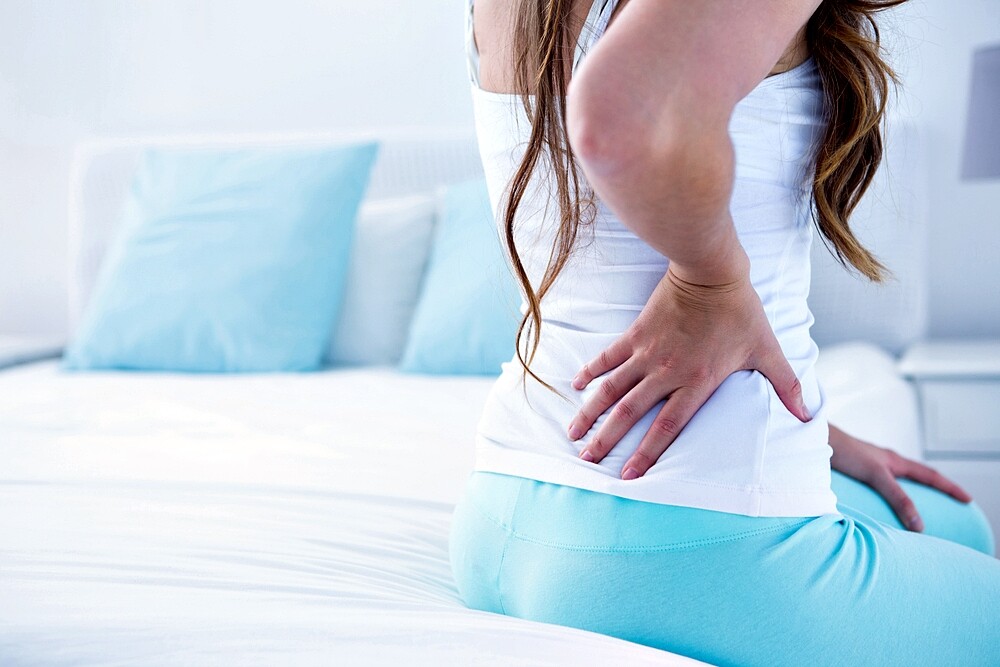What to do for back pain? Whether you suffer from acute or chronic complaints – with our tips you will quickly get rid of your back pain!
It’s no secret that the Americans sit too much. It is therefore not surprising that back pain is one of the most common illnesses in this country – because nowadays it is usually due to lack of exercise. But what to do about back pain?
What to do for back pain?
Back pain is usually treated according to its cause and whether it is acute or chronic. For acute back pain this tip can help:
Step positioning
So-called step positioning often helps against acute, severe pain. Here you lie down carefully on the floor or on a yoga mat, bend your legs and place your calves horizontally on a chair, sofa or similar. The knees should be positioned at an angle of 90 degrees and the lower back should lie completely on the floor. Breathe in and out deeply and stay this way for about two to five minutes at most. To get up, roll over on your side and stand up on your side.
Why does that help?
Acute back pain is alleviated by the stepped positioning, as the spine is relaxed and the intervertebral discs are relieved. If the exercise is performed daily for a few days, it can help release tension and counteract a hollow back.
But the step bearing is not a treatment for permanent pain! Because it is a relieving posture that may even aggravate the cause of the pain. You should not perform it for more than a few days without talking to a doctor.
The best tips against chronic and acute back pain
But there are also other ways to treat acute back pain:
Exercise / Back training
Whereas bed rest used to be the first choice for treatment, doctors today usually recommend exercise for chronic and acute back pain. This may sound absurd at first, after all you are in pain. But the intervertebral discs need movement in order to function. This does not mean, of course, that we have to jog through the park despite the back pain. But there is, for example, targeted back training in the back school, which strengthens the back muscles.
Ergotherapy
In occupational therapy you learn how to cope with back pain in everyday life.
Progressive muscle relaxation
According to US doctor Edmund Jacobsen, progressive muscle relaxation involves tensing individual muscle groups from head to toe one after the other. After a few seconds, the tension is released and the relaxed state is felt for a while. The training should make us more aware of the difference between tensing and relaxing the muscles – this also helps with back pain.
Thermal applications
Especially in the case of slight back pain, many affected people feel warmth as beneficial, for example in the form of a heat plaster or simply by using a hot water bottle at the painful spot. Tensions can be released more easily.
Acupuncture
In Traditional Chinese Medicine, which includes acupuncture, it is assumed that blockages in the life energy chi cause pain. Acupuncture can alleviate pain if it is caused by tense muscles. However, its effect against chronic back pain is only partially proven.
Painkillers
If the pain is severe, the doctor may prescribe medication that either has an anti-inflammatory effect or generally helps against the pain. The medication should only be taken according to the doctor’s instructions – especially in the case of anti-inflammatory drugs, undesirable side effects can occur if they are used for a long time.
Massage
A professional massage releases blockages and loosens tension. Especially those who have to sit a lot in everyday life due to work, can do something good for their back and neck with regular massages.
Where does my back pain actually come from?
The treatment of back pain has changed fundamentally. So has the cause. Today, the spine suffers less often from wear and tear caused by physical work. The cause of complaints is usually the aforementioned lack of movement, constant sitting and permanent stress. According to the Medical Center for Quality in Medicine (ÄZQ), 85 percent of all back patients have no physical cause at all. Back pain is now considered a consequence of our lifestyle, just like diabetes or high blood pressure.
Why a healthy back also has to do with the psyche
Herniated disc, lumbago, irritation of the sciatic nerve, tense muscles – these were the common assumptions for acute back pain in the past. In the meantime it is known that stressful living conditions and the soul can also be behind them. Experts even suspect that stress, work intensification, performance and self-optimization pressure in our society are so weighing on us that back pain has increased continuously in recent years. Doctors should therefore always check whether psychosomatic back pain is the problem.
Healthy living = Healthy back?
In most cases, the victims are women. In all age groups they have acute back pain more often than men. No wonder, after all they react more sensitively to pain – even if the opposite is often claimed. This makes it all the more important that we ourselves pay attention to our lifestyle and incorporate more exercise into our everyday lives. Not only can back pain be relieved in this way, we can also prevent back pain.

